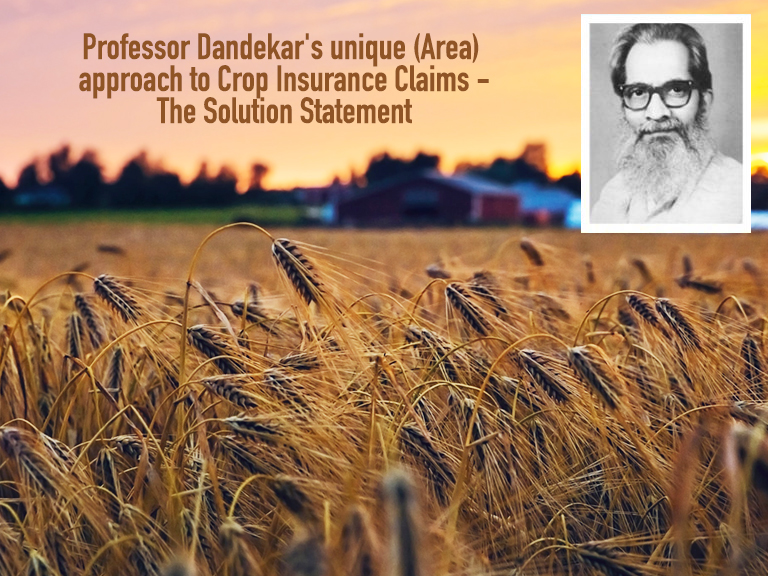In our last discourse, we had looked at some of the baffling problems of implementing a mass based crop insurance scheme in a country such as ours, especially on the Claims side. For Claims to be paid to every individual farmer, yield assessment had apparently to be done for every crop in every plot, across the village, across the Panchayat, across the Tehsil or Taluka, across the District, across the State, and ultimately across the country. This herculean activity had to be carried out twice a year, for both the Kharif and Rabi seasons! The army of yield assessors had to brave the logistical and infrastructural impediments, the circumstantial delays, and complete the work within the small harvesting window in each season! Above all, the entire activity, conducted or sponsored by the insurance company, would reek of prejudice from an “interested party”!!
The problem looked unviable in its economics, unsustainable in its complexity, and insurmountable in its implementability.
This is where Professor V. M. Dandekar came up with another stroke of genius, his prescription of the “Area Approach”. This too was a concept that was magical in its novelty, elegant in its simplicity, and easy in its implementability.
What is this “Area Approach”, and what is its genesis?
You see, in normal lines of insurance, every accident is different from another, and obviously therefore, every damage, loss or injury is different from another. Hence for every accident, a specific survey has to be conducted to assess the exact extent of loss, and accordingly pay the exact amount of repair or replacement.
But in the case of crop insurance, a generalised argument may be made that, unique or targeted accident does not visit a particular plot of land (to the exclusion of its neighbouring plots). In fact, there is no “accident” in the traditional sense of the term, which takes away from the full value of the object of insurance (in this case, the crop). Rather it is the other way round, where the occurrence of natural perils like flood or drought, pests or diseases, would stunt the growth of the crop below its full potential. It follows therefore, that in the case of crop insurance, the nature of the peril in a particular area with similar topography, agro-climatic zone and weather conditions, would be generic rather than specific. In other words, a flood or a drought will affect a large contiguous area in the same or a similar manner, with minimal variations from plot to plot, if at all.
From this supposition emerges the conclusion that, it would not be absolutely necessary to conduct the assessment of yield in every plot of land under insurance. It would suffice, generically speaking, to estimate the shortfall of yield of a crop in percentage terms over a large contiguous area, and apply that percentage of loss to all the plots growing that crop in that area, uniformly. This dramatically eases the whole process, rationalises the expenses of yield estimation, and achieves the broad goal of parametrically estimating the shortfall in yield in every plot in that area under insurance. This is the core rationale of Area Approach.
Again, as with all brilliant solutions, it solved many problems at one stroke. Even with the assessment reduced from plot-wise to Panchayat-wise or Taluka-wise, there would still need to be a huge army of temporary field workers to complete the herculean log of crop cutting experiments within the small harvesting window. The training costs, the expenses of doing the job, and the massive social problem of re-engaging them beyond the 15 days, were all insurmountable in scope and scale. But Professor Dandekar pointed out that the State Govts had already, for ages, been engaged in General Crop Estimation Surveys (GCES), which involved conducting sample crop cutting experiments for various crops in every administrative unit. This was a well settled activity already in vogue, with the responsibility and the resources of one department or other, such as Agriculture, Revenue, or even Economic Services.
These records were available for a long line of past years, and the whole infrastructure and logistics was already well in place. Crop insurance just needed to obtain those very records and apply them to itself. It would be zero cost, it would carry the stamp of the government, and most importantly, it would be neither of the interested parties, but a third umpire. It was the perfect solution.
Thus, “Area Approach” helped to estimate the Current yield of every crop in every contiguous area. Matching this Current yield with the Threshold yield (ie. Guaranteed yield) of that area would produce the yield shortfall for that crop in percentage terms. Applying this loss percentage to the Sum Insured of each farmer growing that crop in that area, would automatically show his Claims in Rupee terms. Now all you had to do was to remit that amount to his crop loan account. Voila!
However much we sing paeans to the great advantages of the Area Approach, it is not enough. There is always more.
Consider this one instance. For any other insurance, the insured (who is the sufferer of loss), has to proactively lodge a claim with the insurance company. Have you noticed that in the case of crop insurance, there is no such process, nor any need at all for the poor farmer to come to the town and file a Claim form in some (to him) intimidating insurance office? The process is so automated, so parametric and statistic driven, that it does not need a trigger (in the shape of Claims lodgement) to be activated. The stakeholders involved in the crop insurance claims process are the State Govts (for yield assessment), the insurance companies (to calculate claims and send remittance) and the banks (to credit the money into the loan accounts of the farmers. The farmer has no pressure on him at all, and one morning would find the Claims amount directly credited to his bank account! Voila again!!
………………….
And thus we come to the end of this story, the saga of the birth of a mass-based crop insurance scheme in India. The simple Indian farmer who feels relieved now that he has taken crop insurance coverage and is assured of his financial stability, may be thankful to his local bank or the insurance company, or even the government, but little does he know about the frail old man, who, with love for them in his heart and wisdom in his head, had devised the path for them to live in security and happiness for evermore!!


